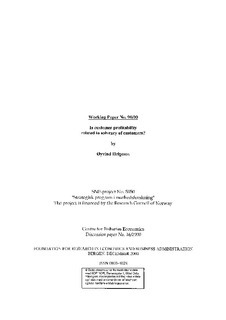Is customer profitability related to solvency of customers?
Working paper, Working paper

Åpne
Permanent lenke
http://hdl.handle.net/11250/165972Utgivelsesdato
2000-12Metadata
Vis full innførselSamlinger
- Working papers (SNF) [809]
Sammendrag
Firms have to consider various ways to analyse their business. However, by many firms it is often asserted that the customers are most important. The sales to customers are generating the cash flows that make the firms able to meet their financial commitments. Furthermore, without customer profitability a firm is not able to generate positive cash flows in the long term. Images of Customer Profitability (ICPs) may be divided into two groups: (1) descriptive; and (2) causal images. Previous to the discussion of the measurements of customer profitability (descriptive CPIs), there is a need for a theoretical understanding of this concept as well as some related theoretical elements or dimensions. These theoretical elements can be divided into four: (1) measures of profitability (i.e. relevant revenues and costs); (2) time; (3) uncertainty; and (4) context. The risk elements are usually divided into three main groups: (1) commercial risks, (2) economic risk, and (3) political risks. The focus of this working paper is on the commercial risks of companies with large exports, and in particular the financial capacity of their customers is addressed (i.e. their ability to pay). The solvency of customers or credit risks (rating codes) can be looked upon as one set of variables that are explaining variations in customer profitability. Furthermore, it can be assumed that the two concepts are closely related. The following hypothesis is tested; (H1): The higher the credit risk of a customer, the higher the relative customer result is obtained. As expected, the findings (results) provide support for this hypothesis, and this implies that the exporting companies may increase customer profitability by increasing the credit risks. Thus, the managers are confronted with the following decision situation: (1) Obtaining high customer results by accepting high risks concerning cash flows; or (2) obtaining lower customer results, with more secure cash flows. Further managerial implications are addressed at the end of this working paper. Finally, some central problems and problem areas and suggestions for further research are presented
Utgiver
SNF / Centre for fisheries economicsSerie
Working paper2000:90
Discussion paper
2000:16